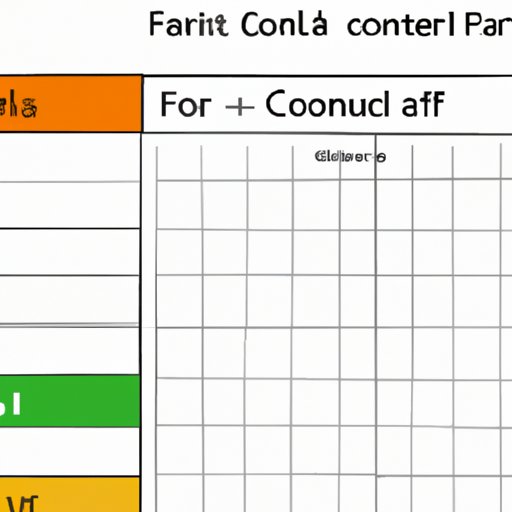Exploring How to Combine Cells in Excel
Excel is a powerful tool that makes it easy to store and manipulate data. However, at times, you may find yourself needing to combine cells to simplify and organize your data. Fortunately, there are a variety of ways to combine cells in Excel, each with its own advantages and unique features. In this article, we will explore several methods for combining cells in Excel, providing step-by-step instructions and tips for using each method effectively.
Using the CONCATENATE function
The CONCATENATE function is a relatively simple way to combine cells in Excel. This function allows you to join multiple text strings into one by adding them together. The function can be used to combine multiple cells, columns, or rows into one, making it an efficient way to organize data. Here’s how to use the CONCATENATE function:
- Select a cell where you want to display the combined text.
- Type the CONCATENATE function “=CONCATENATE(cell1, cell2)” into the cell without the quotes.
- Replace “cell1” and “cell2” with the cell references you want to combine. For example, if you want to combine cells A2 and B2, the formula would be “=CONCATENATE(A2,B2)”
- Press “Enter” and the concatenated text will be displayed in the selected cell.
It’s important to note that the CONCATENATE function can only handle up to 255 text strings. If you need to combine more than 255 text strings, you will need to use the CONCAT function.
Using the ‘&’ operator
The ‘&’ operator is another straightforward way to combine cells in Excel. This operator allows you to join text strings together in a similar way to the CONCATENATE function. Here’s how to use the ‘&’ operator:
- Select a cell where you want to display the combined text.
- Type an equal sign “=” into the cell.
- Type the cell reference for the first cell you want to combine.”
- Type a single ampersand “&” sign.
- Type the cell reference for the second cell you want to combine.”
- Press “Enter” and the combined text will be displayed in the selected cell.
Using the TEXTJOIN function
The TEXTJOIN function provides another way to combine cells in Excel and was first introduced in Excel 2016. This function can combine text from multiple cells, ranges, and even arrays. The TEXTJOIN function is particularly useful because it can ignore empty cells, which can save you time and prevent errors. Here’s how to use the TEXTJOIN function:
- Select a cell where you want to display the combined text.
- Type the TEXTJOIN function “=TEXTJOIN(delimiter, ignore_empty, text1, [text2], …)” into the cell without the quotes.
- Replace “delimiter” with the character or characters you want to use to separate the text in the result.
- Type “TRUE” or “1” to ignore empty cells, or “FALSE” or “0” to include empty cells.
- Replace “text1”, “[text2]”, etc. with the cell references or ranges you want to combine.
- Press “Enter” and the combined text will be displayed in the selected cell.
Using the LEFT, MID, and RIGHT functions
The LEFT, MID, and RIGHT functions can be combined to extract parts of cell values and then combine them. These functions are useful if you need to combine only a portion of a cell’s value. For example, if you have a column of names and email addresses, you could use these functions to extract just the email addresses and combine them into a separate cell. Here’s how to use the functions in combination:
- Select a cell where you want to display the combined text.
- Type the formula “=LEFT(reference, num_characters)&MID(reference, starting_position, num_characters)&RIGHT(reference, num_characters)” into the cell without the quotes.
- Replace “reference” with the cell you want to extract text from.
- Replace “starting_position” with the number of characters you want to skip before extracting text.
- Replace “num_characters” with the number of characters you want to extract.
- Press “Enter” and the combined text will be displayed in the selected cell.
Using the Flash Fill feature
The Flash Fill feature in Excel automatically recognizes patterns in your data and can combine cells accordingly. This feature can save you time and minimize errors. Here’s how to use the Flash Fill feature:
- Type the first few cells in the format you want to combine your data in.
- Press “Ctrl + E” or go to the “Data” tab and select “Flash Fill” to activate the feature.
- The Flash Fill feature will automatically fill in the remaining cells based on the pattern you established.
Using the CONCAT function
The CONCAT function, introduced in Excel 2016, combines cells in a similar way to the CONCATENATE function. However, unlike the CONCATENATE function, the CONCAT function can handle more than 255 text strings. Here’s how to use the CONCAT function:
- Select a cell where you want to display the combined text.
- Type the CONCAT function “=CONCAT(text1, [text2], …)” into the cell without the quotes.
- Replace “text1”, “[text2]”, etc. with the cell references or ranges you want to combine.
- Press “Enter” and the combined text will be displayed in the selected cell.
Conclusion
Combining cells in Excel can be achieved in various ways. Depending on the content you are working with, the situation might favor one method over the other. The CONCATENATE function is straightforward for beginners and works for most use cases, while the TEXTJOIN function is better suited for larger ranges and Excel 2016 users. Using operators such as the ampersand and functions like the LEFT, MID, and RIGHT operations give you more granular control over the output. The Flash Fill feature is ideal for those in a hurry or working on large data sets, while the CONCAT function works better for users needing to combine more than 255 text strings. Interested users should try all of these methods to find the one(s) that work best for them.
